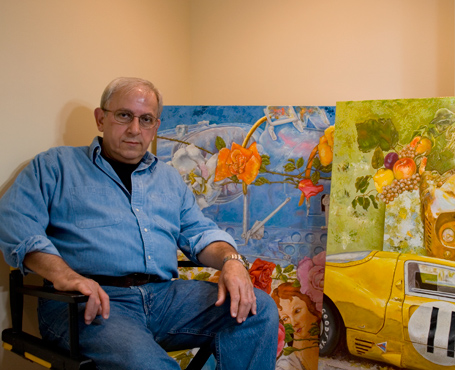Frank DiMartino

Some people live vicariously through the achievements of their children, seeing in each child’s accomplishments the unfulfilled and scattered dreams of their own youth. As for me, I live vicariously through my paintings. I was not destined to be a racecar driver. Few of us possess the required skill and stamina. But I have long felt destined to capture the essence and beauty of racecars in my paintings. In fact, it is the beauty of the automobile, its curves and linear lines, as opposed to the automobile’s performance that is the focus of my art.
My love of automobiles began early in life. As a youngster growing up in Ragusa, Sicily, I was fascinated by the auto races that took place on the narrow streets of my hometown. I was enthralled with the sights and sound of these magnificent machines. My father, an automobile mechanic by trade, raced in the Giro di Sicilia in 1951 and 1952. Similarly, my love of art took root early. I was fortunate to have a mother who herself was an artist. She put aside her own artistic ambitions to raise a family. I like to think that, in my artwork, I am carrying forward the special interests and talents of both my parents.
It is not surprising, therefore, that my early automotive art depicted historic pre-World War II Italian auto races. As I recreated a moment in racecar history, I felt the rush of adrenaline that accompanies a hard fought race. As I tried to reflect the emotion in the face of the victor, I was there as he crossed the finish line. When I portrayed the seemingly frenzied, yet highly orchestrated teamwork of a pit crew, the scent of diesel fuel and burning rubber filled the air. It is that oneness with the subject of my early paintings that I hope those who view my work also experience.
My approach to this unique subject matter is from a Fine Arts background. My formal training includes a Bachelor of Fine Arts in painting and printmaking from Western Kentucky University ('70) and a Master of Fine Arts in painting, printmaking, and drawing from Pratt Institute ('72) in New York. Although I did not know at that time that my career would one day center on automotive art, one of my professors at Pratt, the painter Jacob Lawrence, impressed upon me the importance of finding one’s own style and not merely following a current trend. I have remained true to this philosophy. Hard edge and photo- realism are not my style. I try to bring to my subject matter the grace and elegance of the traditional old masters. They created works of art, renowned for centuries, by using the most basic and pure techniques of their craft. The direction of my most recent works is influenced by the chiaro scuro (light and dark) technique of Caravaggio by which is created the depth and dimension that bring a painting to life. The pastel flowers and angelic faces found in Botticelli’s paintings, to me, blend harmoniously with the beauty of a blue Bugatti. In an arrangement of flowers or fruits I see the same beauty of structure and form as I see in a vintage Alfa Romeo. To the casual observer, this similarity may not be immediately apparent. What does an apple or a flower have to do with an automobile? Nothing, unless you engage in a bit of playful imagining which allows you to see how the roundness of the apple, the soft curl of the flower petal mimic the sleek curvaceousness of the automobile.
I enjoy bringing into my artwork seemingly opposite, and sometimes anachronistic, elements, thus creating new interpretations of my favorite automotive subjects: the Alfa Romeo, the Bugatti and the Ferrari. I treat each car as a still life, giving the linear shapes and curves the same attention to detail usually reserved for more traditional still life subjects.
While I am currently continuing to approach the automobile as a still life, I know that life itself does not stand still. I look ahead to finding new and unique ways to use the automobile in art, ways that will hopefully intrigue and entertain those who, like me, love the automobile.